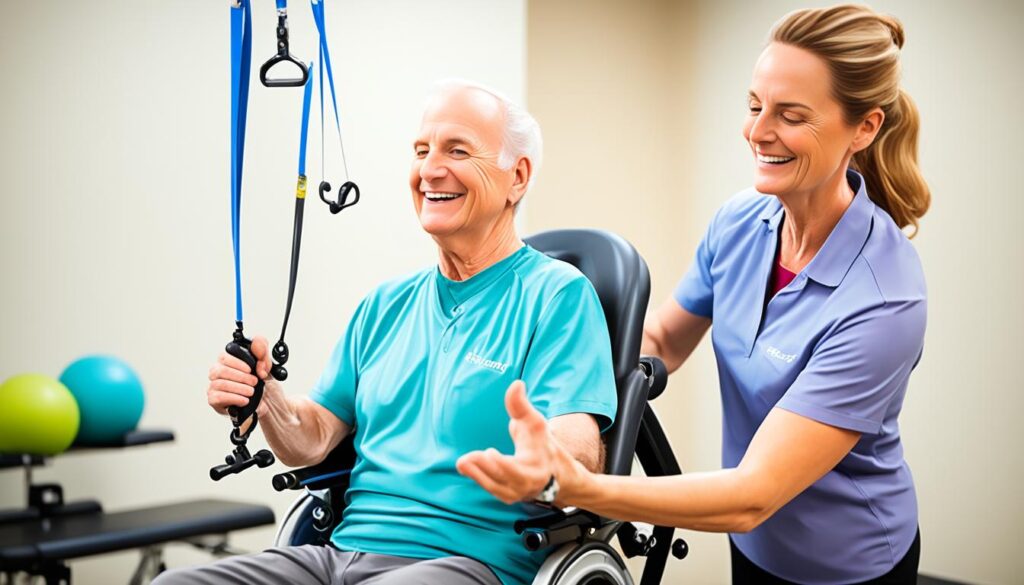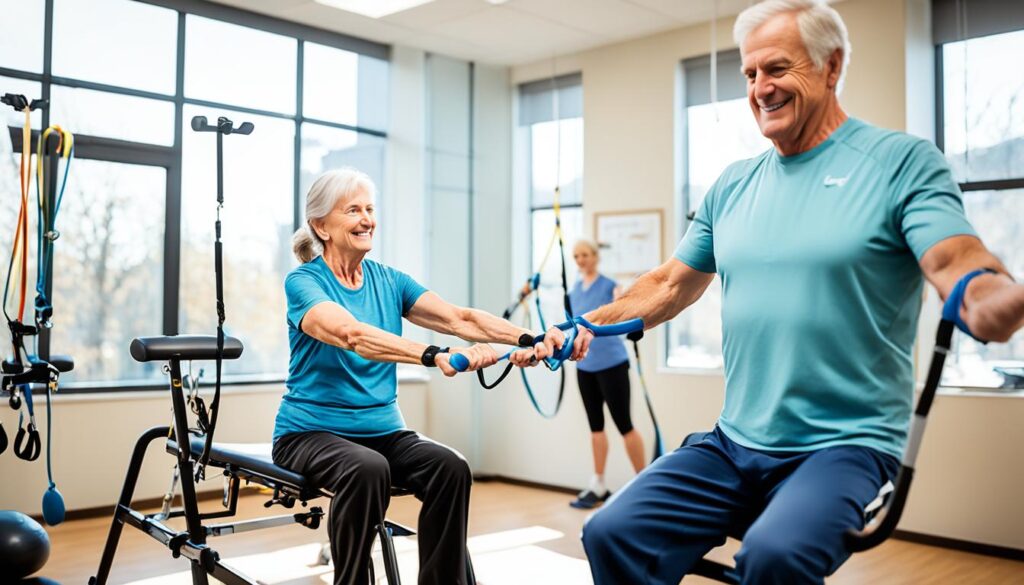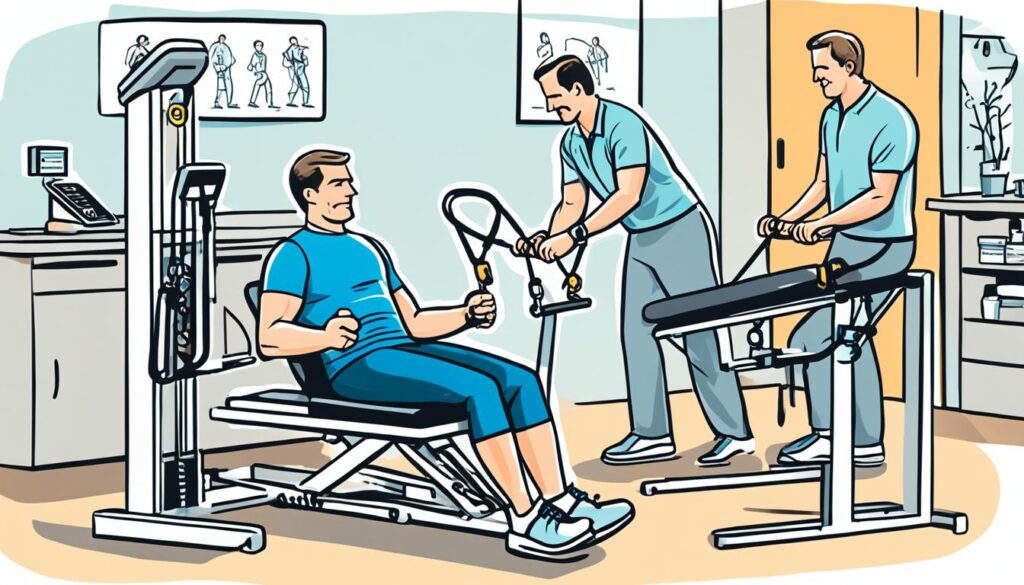Hereditary spastic paraplegia (HSP) is a group of disorders that cause a lot of spasticity and weakness in the legs. HSP can be either pure or complicated, with the complicated type affecting more than just your legs. It can cause problems in different parts of the nervous system, leading to many symptoms.
Physical therapy is very important for people with HSP. It helps manage symptoms and makes life better. The main goals of physical therapy for HSP are to help with moving and flexibility, make muscles stronger, and improve how you live every day.
Table of Contents
ToggleUnderstanding Hereditary Spastic Paraplegia
Hereditary spastic paraplegia, or HSP, is a rare group of inherited disorders. They cause increased muscle tightness and weakness in the lower limbs over time. Genetics mutations harm the upper motor neurons. These neurons control leg movement and muscle tone.
What is Hereditary Spastic Paraplegia?
HSP affects the upper motor neurons, leading to difficulties walking and doing tasks. It’s also known as familial spastic paraplegia. This disorder makes movement and muscle control hard to manage.
Types of Hereditary Spastic Paraplegia
Hereditary spastic paraplegia has several subtypes, each with different genetic mutations. The pure form mainly affects the lower limbs. The complicated form may impact the whole nervous system, leading to more symptoms. These include difficulties with vision, balance, speech, and intellect. Every person with HSP may experience it differently.
Symptoms and Complications
The key symptoms of HSP are increasing muscle tightness and weakness in the legs. This makes walking and normal activities hard. Some people may have sensory issues, trouble thinking, and other nervous system symptoms, based on their subtype and mutation.
Benefits of Physical Therapy
Physical therapy helps a lot with hereditary spastic paraplegia (HSP). It makes life better for those with HSP. Some benefits are:
Improving Mobility and Range of Motion
Exercises in physical therapy help you move better. They also help you use your legs more. This makes daily life easier and helps you be more independent.
Increasing Strength and Coordination
You can work on making your muscles stronger and improving how you move. This helps you do more and be less at risk of falling. It improves your strength, balance, and coordination.
Enhancing Quality of Life
Physical therapy addresses the problems of HSP. It improves how you move and feel. This lets you do more on your own, feel better, and have fun doing what you like.

Physical Therapy Techniques for Hereditary Spastic Paraplegia
Physical therapists use many methods to help those with hereditary spastic paraplegia (HSP). They aim to boost movement, power, and coordination. This helps improve the way of life of these individuals.
Stretching and Flexibility Exercises
Stretching is key in physical therapy for HSP patients. They need to stretch their leg, hip, and back muscles once or twice daily. This is because HSP can limit movement over time.
Aerobic and Strengthening Exercises
Walking, biking, and water exercises are great for those with HSP. They should aim for three to four sessions weekly. Each should last 15 to 60 minutes. Strength training for various muscles is also critical for mobility and health.
Gait Training and Assistive Devices
Improving how they walk is important for HSP patients. Therapists help with this and teach balance skills. They might use walkers or canes to aid walking. This supports keeping mobility and independence.
A mix of these physical therapy exercises can make HSP easier to live with. It helps manage symptoms and boost overall life quality.
Hereditary Spastic Paraplegia Physical Therapy
Physical therapy is key for those with hereditary spastic paraplegia (HSP). It helps them keep or better their movement, strength, and life quality. Therapists make special plans for each person. These plans might have stretching, strength-building, and walking exercises. They also include using devices to help.
Therapists use many ways to help those with HSP. This includes stretching to stay flexible, and exercises to get stronger. They work on walking using things like walkers. This makes it easier for people to move and do things on their own.
Working together, therapists and patients make plans that fit individual needs and goals. They might add swimming or other gentle exercises to help without hurting the body. The main goal is to keep or make the body work better. This allows patients to enjoy daily life.

There’s new hope from ongoing therapy methods and studies. Things like magnetic and electrical activities, plus virtual reality, are making a difference. They are improving movement skills and how patients experience life.
To look after HSP well, a group effort is needed. Physical therapists, neurologists, and others work together. They aim to care for every aspect of the patients’ lives. Working in a team, they create plans that support the independence and happiness of those with HSP.
Tailoring a Personalized Therapy Plan
Creating a therapy plan for hereditary spastic paraplegia starts by looking at what each person needs. Physical therapists closely examine every patient. They look at challenges related to moving, strength, staying upright, and daily tasks.
Assessing Individual Needs and Limitations
After this check-up, they design a plan just for that person. This plan is all about addressing the patient’s specific issues. It helps overcome the problems caused by hereditary spastic paraplegia.
Incorporating Low-Impact and Aquatic Exercises
As part of this plan, therapists often suggest gentle or water exercises. Things like walking, cycling, and sitting exercises offer a softer way to build up moves and power. Warm water activities, on the other hand, give a big hand to those with tight or painful joints. The water lessens the bother on joints and upgrades how the body works.
Emerging Therapies and Research
Researchers and healthcare workers are looking into new ways to help those with hereditary spastic paraplegia (HSP). They’re finding that some treatments show real hope. For example, they are testing out things like transcranial magnetic stimulation and using virtual reality.
Transcranial Magnetic Stimulation
Transcranial magnetic stimulation (TMS) is an exciting method. It doesn’t need surgery and uses magnetic fields. It tries to make certain brain areas work better. This can help with moving and control for people with hereditary spastic paraplegia.
Transspinal Direct Current Stimulation
One more possible treatment is transspinal direct current stimulation (tsDCS). It uses a weak electric current on the spine. This might also improve moving and reduce tight muscles in people with hereditary spastic paraplegia.
Virtual Reality and Exergaming
Virtual reality (VR) and games might help, too. They make physical therapy more fun. Those with HSP can try out games that challenge moving and balance. This can help them get stronger and make life more enjoyable. therapies.

Managing Hereditary Spastic Paraplegia: A Multidisciplinary Approach
Helping people with hereditary spastic paraplegia (HSP) works best when many healthcare workers join forces. These experts team up to make a care plan covering physical, emotional, and mental needs.
Collaborating with Healthcare Professionals
A care team for HSP often includes physical therapists, occupational therapists, neurologists, and family doctors. They all work together to understand the patient’s challenges and plan a special approach to help them. This teamwork makes sure the patient gets care for everything from moving better and getting stronger to feeling better emotionally and mentally.
Addressing Emotional and Psychological Needs
Having a condition like HSP can be tough emotionally and mentally for both patients and their families. The care team is there to help with emotional and mental health, such as talking to a counselor or joining support groups. Dealing with these needs helps the patients and their families handle HSP better and enjoy life more.
Conclusion
Physical therapy is important for managing hereditary spastic paraplegia. It offers many benefits to keep or improve your mobility, strength, and life quality. Therapists use stretching, exercises, and other methods to create a personalized treatment plan for you.
Many studies have looked at how physical therapy can help with this condition. They have tested different therapies like transcranial magnetic stimulation and virtual reality rehab. These studies show that physical therapy can make a big difference in how you live with this disease.
When dealing with hereditary spastic paraplegia, working with a team of experts is crucial. This team includes physical therapists, neurologists, and occupational therapists. They help you create a plan that meets your physical and emotional needs. With the right care and support, you can lead a full life despite the challenges.
FAQ
What is hereditary spastic paraplegia?
What causes hereditary spastic paraplegia?
How does physical therapy help with hereditary spastic paraplegia?
What techniques do physical therapists use to treat hereditary spastic paraplegia?
How do physical therapists tailor a treatment plan for someone with hereditary spastic paraplegia?
What emerging therapies are being explored for hereditary spastic paraplegia?
How does a multidisciplinary approach help manage hereditary spastic paraplegia?
Source Links
- https://www.ncbi.nlm.nih.gov/pmc/articles/PMC10716443/
- https://sp-foundation.org/understanding-pls-hsp/treatments-therapies-pages/physical-therapy-and-exercise.html
- https://emedicine.medscape.com/article/306713-treatment
- https://www.ncbi.nlm.nih.gov/pmc/articles/PMC6642887/
- https://www.ncbi.nlm.nih.gov/pmc/articles/PMC8835766/
- https://www.ncbi.nlm.nih.gov/pmc/articles/PMC8009193/
- https://www.ncbi.nlm.nih.gov/pmc/articles/PMC6349696/
- https://link.springer.com/article/10.1007/s10072-023-07200-1
- https://touchneurology.com/movement-disorders/journal-articles/how-can-we-improve-current-practice-in-spastic-paresis/
- https://www.medicaljournals.se/jrm/content/html/10.2340/16501977-2227

Best Neurologist Doctor In Patna: Dr Chandril Chugh Dedicated to Your Well-being
Dr.Chandril Chugh is a neurologist who trained and practiced in the USA for more than a decade. He is compassionate and caring and is most well known for being a patient listener and spending ample time with patients.
